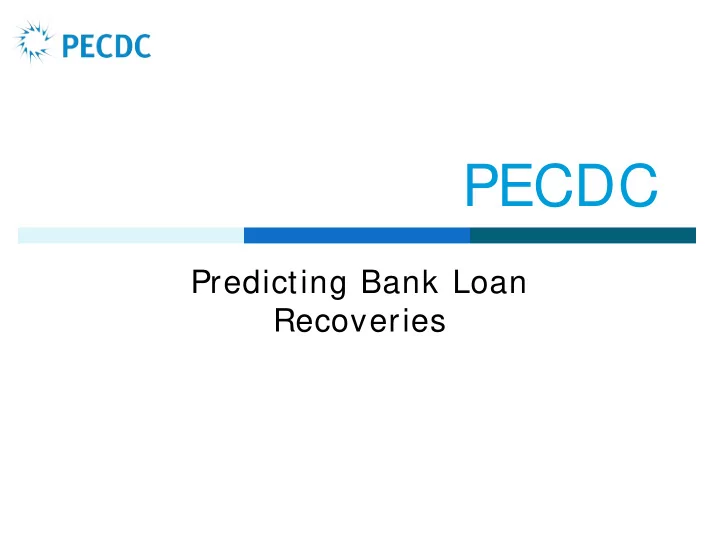

PECDC Predicting Bank Loan Recoveries
Agenda Challenges and importance of modeling LGD How to construct a database Preparation steps for modeling Modeling approaches Increasing the dataset size Conclusion 2
Modeling in a qualitative world Wines are the best when grapes are ripe (lower acidity) and the juice is concentrated In hot summers the grapes get ripe and with low rain fall they get more concentrated Regression analysis by Orley Ashenfelter: Wine quality (auction price) = 12.145 + 0.00117 winter rainfall + 0.0614 average growing season temperature – 0.00386 harvest rain Reaction by the most famous wine critics: “Somewhere between violent and hysterical” “An absolute sham” “It ’ s really a Neanderthal way of looking at wine” “I’d hate to be invited to his house to drink wine” 3
LGD modeling is important LGD’s are equally as important as defaults The supervisor requires LGD and downturn LGD (Very Challenging) There is more uncertainty around LGD’s than PD’s 4
Uncertainty about LGD estimates Comparison Basel 2 estimates and CRA estimates 6,00 5,00 4,00 CRA 1 3,00 CRA 2 2,00 1,00 - Avg Pd (1 year) Avg LGD Avg Loss (1 year) Based on an European SME securitization end of 2009. 5
To model LGD you need Model LGD Predictor Para- obser- variables meters vations 12.145 + 0.00117 winter rainfall + 0.0614 average growing season temperature – 0.00386 harvest rain = Wine quality (auction price) 6
EAD D & LGD GD da data taba base str truc ucture 118 d different nt d data fields ds p per defaul aulted o d obligor Covering 4 4 snap apshots i in t time Cash flow ow i infor orma mati tion: origin inatio ion Default De lt 1 year 1 ye ar Resoluti tion on Amount, date, currency, cash flow type, prio ior t r to source of cash flow, liquidated collateral id defau ault Inform ormation on o on Borro rrower: • Borrow rrower l r level, Collatera ral l Level: l: Reason of default, Financial, Country, • Loan an l level an and d Collateral type, Book value, Market Value, Business, Legal structure, Jurisdiction, Valuation date, Ranking, Jurisdiction, Operating, Pd rating etc. • coll llate teral l l level Ship/Aircraft / Project type , Contingent obligations Loan Le Lo Level: Facility type, syndicated, repayment structure, Seniority, Maturity date, Limit, outstanding amount, LGD rating 7
Variety of asset classes 31,803 Small/Medium Enterprise 10000 (SME) Large Corporate 9000 7,253 8000 Aircraft Finance 7000 Banks 6000 Project Finance 5000 Real Estate Finance 4000 Shipping Finance 3000 Commodities Finance 1,244 2000 507 493 287 Private Banking 218 195 1000 55 22 26 0 Asset C Asse Class ss 8
Many facility types Overdraft Term Loan Amortized without Balloon 727 Term Loan Bullet 657 615 795 1,250 1,122 Payment Guarantee and Stand By LC's 1,691 10,890 Revolver/Line > 1 year Receivables Financing 2,127 Operating Lease 2,856 Revolver/Term Loan 3,172 8,876 Demand Loan 5,753 Revolver/Line < 1 year Term Loan Amortized with Balloon Other/Unknown Trade Related Documentary Credit Capital Lease 9
PECDC LGD observations 10
Predictor variables Bank loans have many different appearances: cash and non cash utilization repayment seniority collateral jurisdiction Predictor variables selection: Literature Observations in the database 11
LGD: Two stochastic variables LGD = EAD -/ - recovery cash flows EAD is driven by facility type covenants bank behavior managing down the exposure triggering the default Recovery cash flows quality of the obligor Seniority jurisdiction collateral 12
Interpretation of the database Are secured loans the same as unsecured loans plus collateral? What is the impact of covenants? What is driving the recovery and where does the cash come from? Is there a difference in default registration between i.e. secured and subordinated loans? 13
Are some loans more in default? Company Value Restructuring for subordinated Restructuring for secured loans Bankruptcy Time 14
Modeling approach LGD modeling for before default after default Approach Linear model violates normal and homoskedastic residuals Log-linear model (NIBC) Dealing with the Bimodal distribution of LGD’s (NIBC) Two-step approach Logistic model Loss Given Loss Model Survival Analysis in Time (Danske Bank) Alternatives Assuming a Beta distribution 15
Two step approach Prob Prob Loss | Default Loss | Loss 16
Modeling steps Manipulating the predictor variables Perform calculations Relabeling/ grouping of data fields Changing data fields into a reusable formats (empty or zero) Capping LGD’s between 0% and 150% Continuous variables, discrete variables and dummy variables Creation of a Reference Dataset Exclusion of small exposures Exclusion of over and underpayments Exclusion of biased years Regressions Backward elimination based on lack of significance and multi collineairity Analysis of explanatory power and correlation with observed LGD’s 17
Variables Pre- Post Signi- Variables Default Default ficance Continuous Variables ln Default Amount X X S S Significant Guarantor Amount Percentage X X S o Insignificant Collateral Amount Perecentage X X S ln Entity Sales X X o Utilized Percentage X X o Principal Advances Percentage X S Discrete Variables Number of Facilities X X S Age of Facility in Years X X o Dummy Variables Country group X X S Industry group X X S Seniority Level X X S Guaranteed X X S Collateralized X X S Multiple Facilities X X S Public or Private (or SPV) X X S Operating Company X X S Syndicated Loan X X o Reason for Default 18 X S Advancements after Default X S
Using unresolved defaults to increase the data base 19
Conclusion Modeling LGD is difficult What is needed? Proper understanding of the lending business Representative, large, unbiased and detailed datasets Increase the dataset by using unresolved defaults We need more research and data collection to get to the LGD models we ideally want. 20
The best moment to plant a tree is 20 years ago, the second best is today 21
Recommend
More recommend